Closed Water Systems
Newly installed closed systems, LTHW, MTHW, HTHW, Chilled Water and Condenser Water circuits should generally be pre-commission cleaned. The vast majority of these systems have small bore control valves, regulating valves etc, which readily become blocked with particulate matter and would then fail to operate. It is therefore important to ensure the presence of acceptable water quality prior to putting the system into use. Debris that is present in a system as a result of the installation process needs to be removed.
Cleaning systems prior to an initial balance is very important. Preceding the balance all valves can be fully opened and flushing flows maximised and manipulated to ensure that all possible debris is removed from the pipework. It is rare that such an opportunity will present itself again since once a building is commissioned and occupied, regulating valves in the system will be at a set position with reduced orifice sizes to effect a system proportional balance. The use of chemical enhances the cleaning process by removing soluble contaminants.
BSRIA BG29-2012 'Pre-commission Cleaning of Pipework Systems' outlines the methodology for cleaning new systems. (BSRIA website) In addition this guidance document outlines the responsibilities of designers and installing contractors. These should be taken seriously since poorly designed systems cannot be adequately cleaned and systems installed without correct flushing facilities require additional installation work prior to flushing and cleaning.
We strongly recommend that pre-commission cleaning works are fully recorded and witnessed and that samples are taken to demonstrate cleanliness on completion. In addition we recommend that samples are taken at practical completion on a building site contract to demonstrate compliance with the specification for the new building.
Witnessing cleaning of a strainer after a pre-commission flush (picture right): Following pre-commission cleaning it is important that closed systems are carefully monitored and regularly maintained. This maintenance should continue throughout the life of the building and should involve sample taking at a maximum interval of 3 months.
BSRIA 50/2013 provides details on the management of systems after completion of the building phase.
Older systems can require cleaning for many reasons including:
BSRIA 50/2013 refers to cleaning strategies but BSRIA 29/2012 is also useful for detailed description of cleanup phases.
Debris removed from a flexible hose on a contaminated system (picture right): Once systems have been operational it is probable that any contaminants that are present will not be confined to main pipework. In fact they are more likely to collect in low flow areas such as FCU coils, AHU coils etc. and in small orifices such as low or ultra low flow commissioning stations. In addition debris in older systems may be associated with corrosion pits and nodules and may therefore be more difficult to remove.
Side stream filters are an essential tool when cleaning existing systems (picture right): In general the flushing principles outlined in BSRIA 29/2012 guidance need to be adapted to suit the particular design and needs of the system and it is probable that the scope of work will be more extensive than for a pre-commission clean. Choice of chemicals is more difficult in operational systems and the programme often has to be adapted to allow systems to be operational and providing heating and cooling to client's requirements whilst also allowing an effective scope of work. It is our experience that the precise methodology for improving water quality in operational systems varies from one building to another.
Tests to ascertain the efficacy of a proposed cleaning chemical on a section of pipework (picture below): When cleaning older pipework it is important to select a scope of work which limits the risk of exposing areas of weakness in pipework but allows the maximum possible benefit. In general the cleaning of operational systems is undertaken to improve operating conditions, create a basis from which ongoing maintenance can be undertaken and increase the longevity of the plant and pipework. It is never possible to render the pipework as new.
Cleaning systems prior to an initial balance is very important. Preceding the balance all valves can be fully opened and flushing flows maximised and manipulated to ensure that all possible debris is removed from the pipework. It is rare that such an opportunity will present itself again since once a building is commissioned and occupied, regulating valves in the system will be at a set position with reduced orifice sizes to effect a system proportional balance. The use of chemical enhances the cleaning process by removing soluble contaminants.
BSRIA BG29-2012 'Pre-commission Cleaning of Pipework Systems' outlines the methodology for cleaning new systems. (BSRIA website) In addition this guidance document outlines the responsibilities of designers and installing contractors. These should be taken seriously since poorly designed systems cannot be adequately cleaned and systems installed without correct flushing facilities require additional installation work prior to flushing and cleaning.
- It is important to get systems properly cleaned in accordance with the guideline. In the event that the process fails subsequent cleaning becomes more difficult for the following reasons:
- Debris will have become trapped in small valve orifices, FCU coils, chillers etc. These areas are generally protected, by means of bypassing, until after the initial cleaning process.
- Debris can become baked onto the pipe walls and heat exchange surfaces with the passage of time.
- Microbiological problems can commence and become a serious problem in the presence of retained debris.
We strongly recommend that pre-commission cleaning works are fully recorded and witnessed and that samples are taken to demonstrate cleanliness on completion. In addition we recommend that samples are taken at practical completion on a building site contract to demonstrate compliance with the specification for the new building.
Witnessing cleaning of a strainer after a pre-commission flush (picture right): Following pre-commission cleaning it is important that closed systems are carefully monitored and regularly maintained. This maintenance should continue throughout the life of the building and should involve sample taking at a maximum interval of 3 months.
Cleaning Older/Operational Systems
BSRIA 50/2013 provides details on the management of systems after completion of the building phase.
Older systems can require cleaning for many reasons including:
- Failure of the pre-commission cleaning
- Failure of fittings and equipment
- Inadequate maintenance
- Drain down/alterations allowing deterioration in water conditions
- Requirements to upgrade or alter pipework and fittings
BSRIA 50/2013 refers to cleaning strategies but BSRIA 29/2012 is also useful for detailed description of cleanup phases.
Debris removed from a flexible hose on a contaminated system (picture right): Once systems have been operational it is probable that any contaminants that are present will not be confined to main pipework. In fact they are more likely to collect in low flow areas such as FCU coils, AHU coils etc. and in small orifices such as low or ultra low flow commissioning stations. In addition debris in older systems may be associated with corrosion pits and nodules and may therefore be more difficult to remove.
Side stream filters are an essential tool when cleaning existing systems (picture right): In general the flushing principles outlined in BSRIA 29/2012 guidance need to be adapted to suit the particular design and needs of the system and it is probable that the scope of work will be more extensive than for a pre-commission clean. Choice of chemicals is more difficult in operational systems and the programme often has to be adapted to allow systems to be operational and providing heating and cooling to client's requirements whilst also allowing an effective scope of work. It is our experience that the precise methodology for improving water quality in operational systems varies from one building to another.
Tests to ascertain the efficacy of a proposed cleaning chemical on a section of pipework (picture below): When cleaning older pipework it is important to select a scope of work which limits the risk of exposing areas of weakness in pipework but allows the maximum possible benefit. In general the cleaning of operational systems is undertaken to improve operating conditions, create a basis from which ongoing maintenance can be undertaken and increase the longevity of the plant and pipework. It is never possible to render the pipework as new.
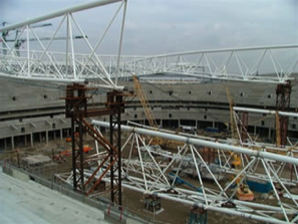
Closed Systems - Pre-commission Cleaning
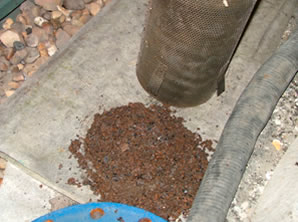
Witnessing cleaning of a strainer after a pre-commission flush
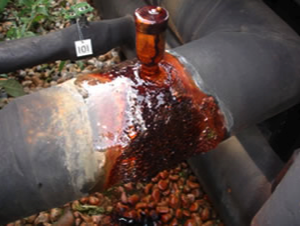
A vent that requires attention
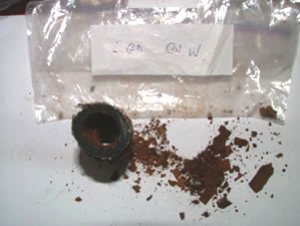
Debris removed from a flexible hose on a contaminated system
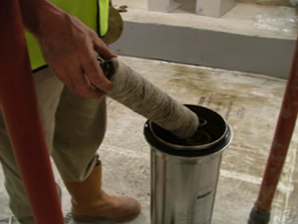
Side stream filters are an essential tool when cleaning existing systems
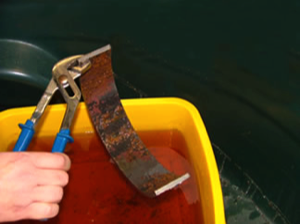
Tests to ascertain the efficacy of a proposed cleaning chemical on a section of pipework
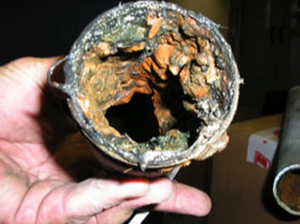
Corrosion debris present in an older system
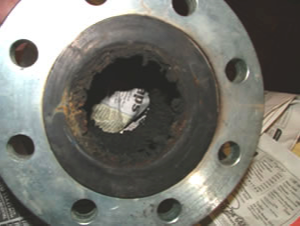
Rubber failure on a problem system
